2013 VOLKSWAGEN TOUAREG airbag off
[x] Cancel search: airbag offPage 38 of 440
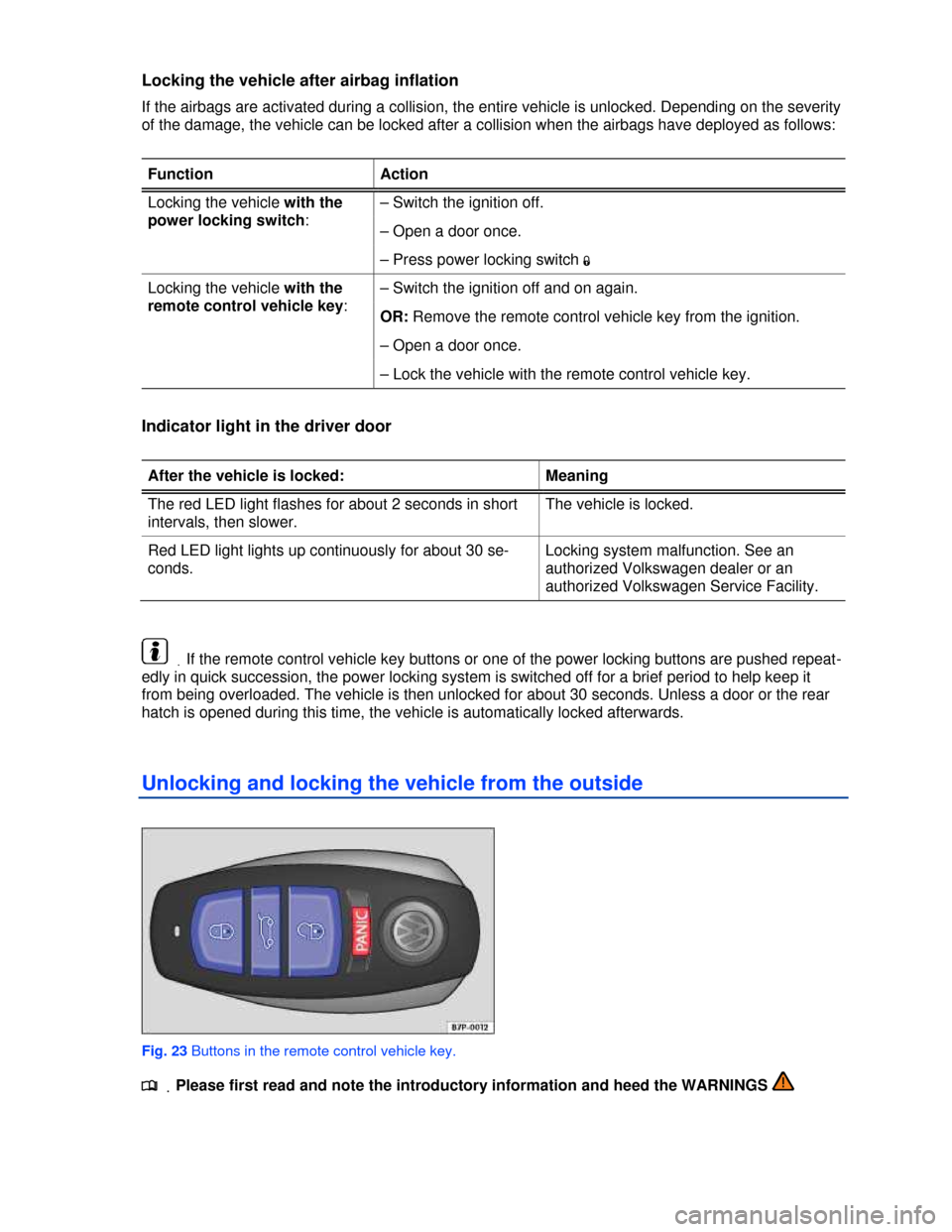
Locking the vehicle after airbag inflation
If the airbags are activated during a collision, the entire vehicle is unlocked. Depending on the severity
of the damage, the vehicle can be locked after a collision when the airbags have deployed as follows:
Function Action
Locking the vehicle with the
power locking switch:
– Switch the ignition off.
– Open a door once.
– Press power locking switch �1
Locking the vehicle with the
remote control vehicle key:
– Switch the ignition off and on again.
OR: Remove the remote control vehicle key from the ignition.
– Open a door once.
– Lock the vehicle with the remote control vehicle key.
Indicator light in the driver door
After the vehicle is locked: Meaning
The red LED light flashes for about 2 seconds in short
intervals, then slower.
The vehicle is locked.
Red LED light lights up continuously for about 30 se-
conds.
Locking system malfunction. See an
authorized Volkswagen dealer or an
authorized Volkswagen Service Facility.
.If the remote control vehicle key buttons or one of the power locking buttons are pushed repeat-
edly in quick succession, the power locking system is switched off for a brief period to help keep it
from being overloaded. The vehicle is then unlocked for about 30 seconds. Unless a door or the rear
hatch is opened during this time, the vehicle is automatically locked afterwards.
Unlocking and locking the vehicle from the outside
Fig. 23 Buttons in the remote control vehicle key.
.�
Page 101 of 440
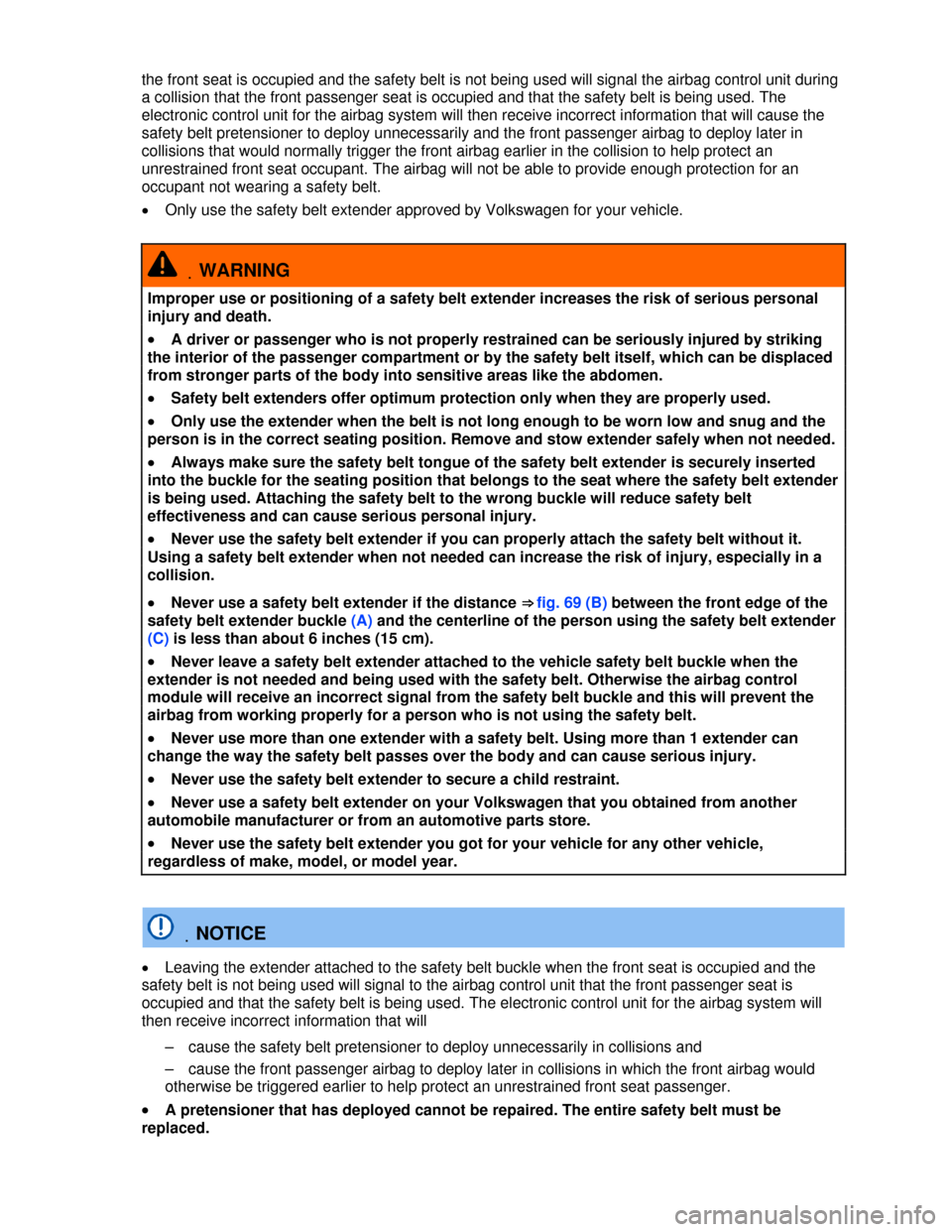
the front seat is occupied and the safety belt is not being used will signal the airbag control unit during
a collision that the front passenger seat is occupied and that the safety belt is being used. The
electronic control unit for the airbag system will then receive incorrect information that will cause the
safety belt pretensioner to deploy unnecessarily and the front passenger airbag to deploy later in
collisions that would normally trigger the front airbag earlier in the collision to help protect an
unrestrained front seat occupant. The airbag will not be able to provide enough protection for an
occupant not wearing a safety belt.
�x Only use the safety belt extender approved by Volkswagen for your vehicle.
.WARNING
Improper use or positioning of a safety belt extender increases the risk of serious personal
injury and death.
�x A driver or passenger who is not properly restrained can be seriously injured by striking
the interior of the passenger compartment or by the safety belt itself, which can be displaced
from stronger parts of the body into sensitive areas like the abdomen.
�x Safety belt extenders offer optimum protection only when they are properly used.
�x Only use the extender when the belt is not long enough to be worn low and snug and the
person is in the correct seating position. Remove and stow extender safely when not needed.
�x Always make sure the safety belt tongue of the safety belt extender is securely inserted
into the buckle for the seating position that belongs to the seat where the safety belt extender
is being used. Attaching the safety belt to the wrong buckle will reduce safety belt
effectiveness and can cause serious personal injury.
�x Never use the safety belt extender if you can properly attach the safety belt without it.
Using a safety belt extender when not needed can increase the risk of injury, especially in a
collision.
�x Never use a safety belt extender if the distance ⇒ fig. 69 (B) between the front edge of the
safety belt extender buckle (A) and the centerline of the person using the safety belt extender
(C) is less than about 6 inches (15 cm).
�x Never leave a safety belt extender attached to the vehicle safety belt buckle when the
extender is not needed and being used with the safety belt. Otherwise the airbag control
module will receive an incorrect signal from the safety belt buckle and this will prevent the
airbag from working properly for a person who is not using the safety belt.
�x Never use more than one extender with a safety belt. Using more than 1 extender can
change the way the safety belt passes over the body and can cause serious injury.
�x Never use the safety belt extender to secure a child restraint.
�x Never use a safety belt extender on your Volkswagen that you obtained from another
automobile manufacturer or from an automotive parts store.
�x Never use the safety belt extender you got for your vehicle for any other vehicle,
regardless of make, model, or model year.
.NOTICE
�x Leaving the extender attached to the safety belt buckle when the front seat is occupied and the
safety belt is not being used will signal to the airbag control unit that the front passenger seat is
occupied and that the safety belt is being used. The electronic control unit for the airbag system will
then receive incorrect information that will
– cause the safety belt pretensioner to deploy unnecessarily in collisions and
– cause the front passenger airbag to deploy later in collisions in which the front airbag would
otherwise be triggered earlier to help protect an unrestrained front seat passenger.
�x A pretensioner that has deployed cannot be repaired. The entire safety belt must be
replaced.
Page 173 of 440
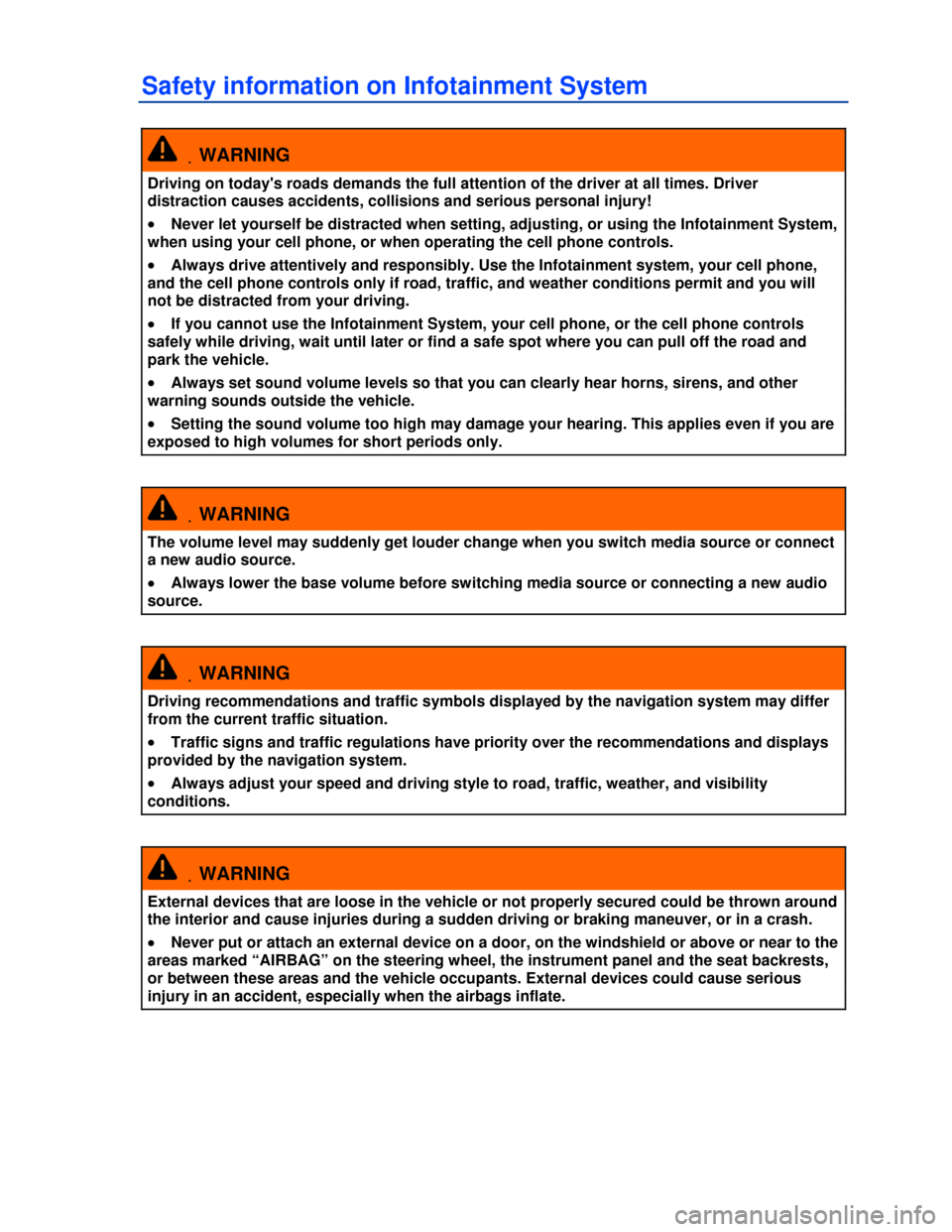
Safety information on Infotainment System
.WARNING
Driving on today's roads demands the full attention of the driver at all times. Driver
distraction causes accidents, collisions and serious personal injury!
�x Never let yourself be distracted when setting, adjusting, or using the Infotainment System,
when using your cell phone, or when operating the cell phone controls.
�x Always drive attentively and responsibly. Use the Infotainment system, your cell phone,
and the cell phone controls only if road, traffic, and weather conditions permit and you will
not be distracted from your driving.
�x If you cannot use the Infotainment System, your cell phone, or the cell phone controls
safely while driving, wait until later or find a safe spot where you can pull off the road and
park the vehicle.
�x Always set sound volume levels so that you can clearly hear horns, sirens, and other
warning sounds outside the vehicle.
�x Setting the sound volume too high may damage your hearing. This applies even if you are
exposed to high volumes for short periods only.
.WARNING
The volume level may suddenly get louder change when you switch media source or connect
a new audio source.
�x Always lower the base volume before switching media source or connecting a new audio
source.
.WARNING
Driving recommendations and traffic symbols displayed by the navigation system may differ
from the current traffic situation.
�x Traffic signs and traffic regulations have priority over the recommendations and displays
provided by the navigation system.
�x Always adjust your speed and driving style to road, traffic, weather, and visibility
conditions.
.WARNING
External devices that are loose in the vehicle or not properly secured could be thrown around
the interior and cause injuries during a sudden driving or braking maneuver, or in a crash.
�x Never put or attach an external device on a door, on the windshield or above or near to the
areas marked “AIRBAG” on the steering wheel, the instrument panel and the seat backrests,
or between these areas and the vehicle occupants. External devices could cause serious
injury in an accident, especially when the airbags inflate.
Page 293 of 440
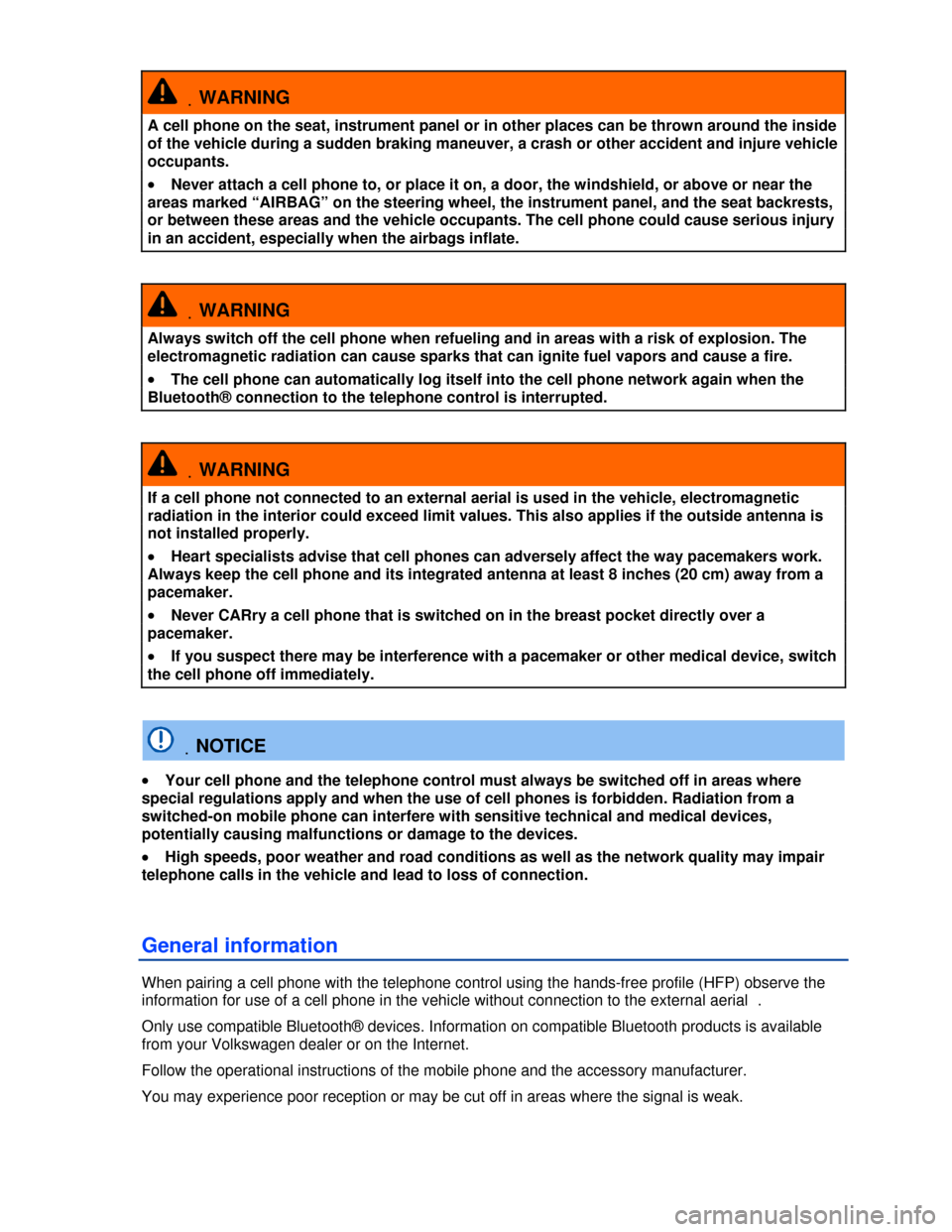
.WARNING
A cell phone on the seat, instrument panel or in other places can be thrown around the inside
of the vehicle during a sudden braking maneuver, a crash or other accident and injure vehicle
occupants.
�x Never attach a cell phone to, or place it on, a door, the windshield, or above or near the
areas marked “AIRBAG” on the steering wheel, the instrument panel, and the seat backrests,
or between these areas and the vehicle occupants. The cell phone could cause serious injury
in an accident, especially when the airbags inflate.
.WARNING
Always switch off the cell phone when refueling and in areas with a risk of explosion. The
electromagnetic radiation can cause sparks that can ignite fuel vapors and cause a fire.
�x The cell phone can automatically log itself into the cell phone network again when the
Bluetooth® connection to the telephone control is interrupted.
.WARNING
If a cell phone not connected to an external aerial is used in the vehicle, electromagnetic
radiation in the interior could exceed limit values. This also applies if the outside antenna is
not installed properly.
�x Heart specialists advise that cell phones can adversely affect the way pacemakers work.
Always keep the cell phone and its integrated antenna at least 8 inches (20 cm) away from a
pacemaker.
�x Never CARry a cell phone that is switched on in the breast pocket directly over a
pacemaker.
�x If you suspect there may be interference with a pacemaker or other medical device, switch
the cell phone off immediately.
.NOTICE
�x Your cell phone and the telephone control must always be switched off in areas where
special regulations apply and when the use of cell phones is forbidden. Radiation from a
switched-on mobile phone can interfere with sensitive technical and medical devices,
potentially causing malfunctions or damage to the devices.
�x High speeds, poor weather and road conditions as well as the network quality may impair
telephone calls in the vehicle and lead to loss of connection.
General information
When pairing a cell phone with the telephone control using the hands-free profile (HFP) observe the
information for use of a cell phone in the vehicle without connection to the external aerial .
Only use compatible Bluetooth® devices. Information on compatible Bluetooth products is available
from your Volkswagen dealer or on the Internet.
Follow the operational instructions of the mobile phone and the accessory manufacturer.
You may experience poor reception or may be cut off in areas where the signal is weak.
Page 330 of 440
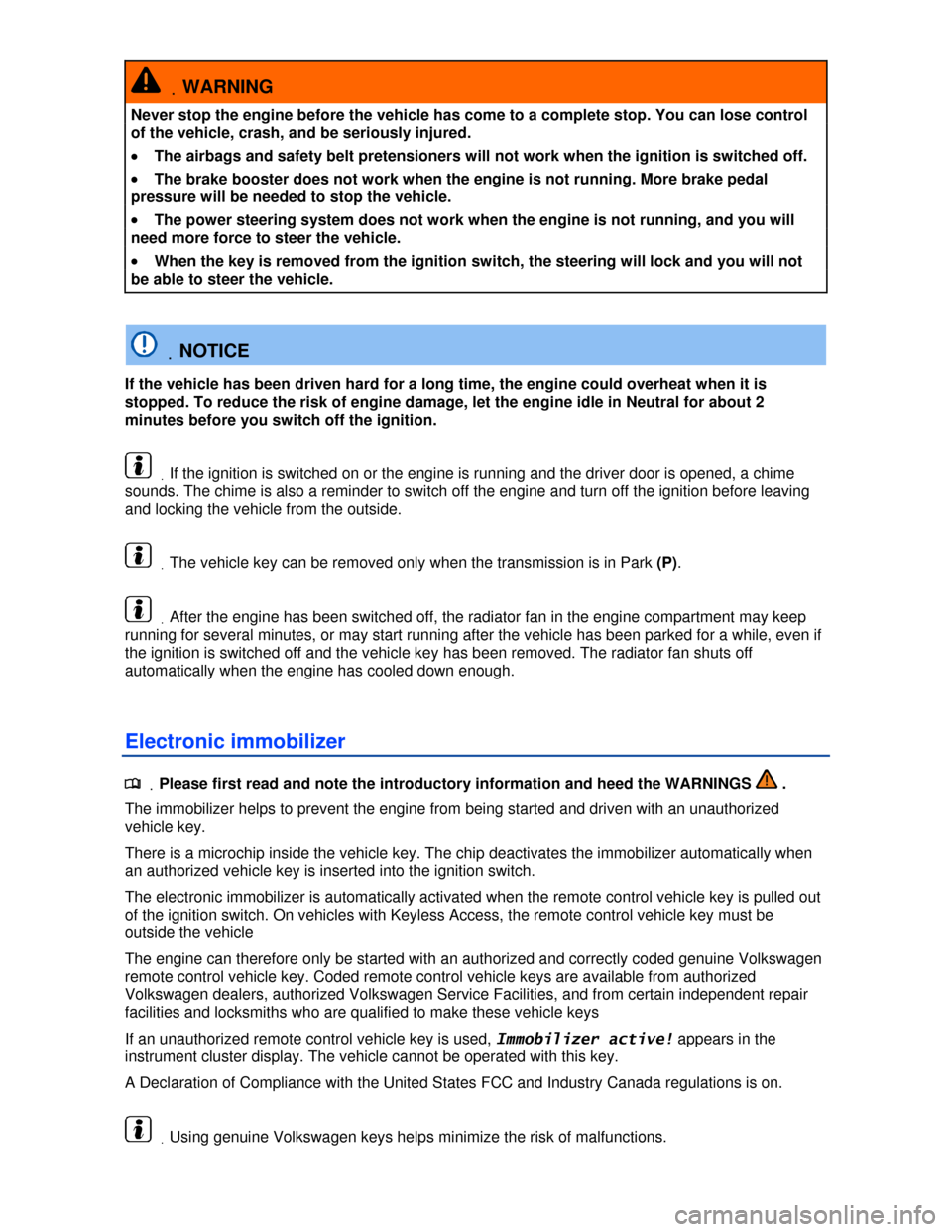
.WARNING
Never stop the engine before the vehicle has come to a complete stop. You can lose control
of the vehicle, crash, and be seriously injured.
�x The airbags and safety belt pretensioners will not work when the ignition is switched off.
�x The brake booster does not work when the engine is not running. More brake pedal
pressure will be needed to stop the vehicle.
�x The power steering system does not work when the engine is not running, and you will
need more force to steer the vehicle.
�x When the key is removed from the ignition switch, the steering will lock and you will not
be able to steer the vehicle.
.NOTICE
If the vehicle has been driven hard for a long time, the engine could overheat when it is
stopped. To reduce the risk of engine damage, let the engine idle in Neutral for about 2
minutes before you switch off the ignition.
.If the ignition is switched on or the engine is running and the driver door is opened, a chime
sounds. The chime is also a reminder to switch off the engine and turn off the ignition before leaving
and locking the vehicle from the outside.
.The vehicle key can be removed only when the transmission is in Park (P).
.After the engine has been switched off, the radiator fan in the engine compartment may keep
running for several minutes, or may start running after the vehicle has been parked for a while, even if
the ignition is switched off and the vehicle key has been removed. The radiator fan shuts off
automatically when the engine has cooled down enough.
Electronic immobilizer
.�
Page 392 of 440

In order to: You must ⇒fig.134Result:
Reduce set speed (while
cruise control is actively
controlling vehicle
speed).
Push the lever briefly to the
�3�0�%�%�$ – position (–) to reduce
speed in increments of 5 mph
(10 km/h) and store.
Cruise control will slow the vehicle
down without braking by reducing the
flow of fuel to the engine until the new
lower speed is reached and saves the
new lower speed in the memory. Push and hold the lever in the
�3�0�%�%�$ – position (–) to reduce the
set speed until the lower desired
speed is reached and the button
is released.
Switch off cruise control. Move the lever to the �/�&�&position
(B).
System is switched off. The set speed
is deleted.
Driving downhill with cruise control
If cruise control cannot maintain constant speed while driving downhill, slow the vehicle with the foot
brake and downshift if necessary.
Automatic deactivation
Cruise control speed regulation is automatically deactivated or temporarily interrupted:
�x If the system detects an error that could affect the function of the cruise control.
�x If the vehicle has accelerated and goes faster than the stored speed for a longer time.
�x If the brake or clutch pedal is depressed.
�x If the vehicle shifts gear (manual transmission).
�x If an airbag deploys.